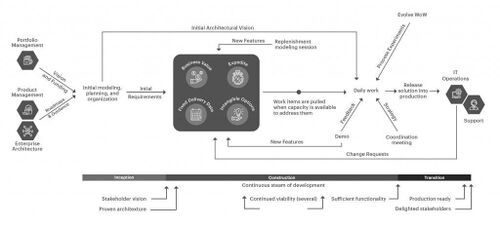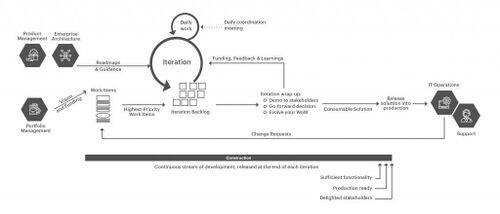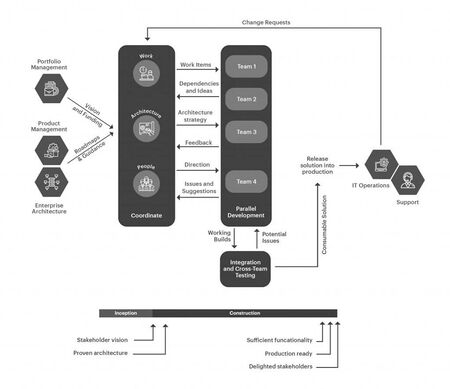Disciplined Agile Delivery (DAD)
Disciplined Agile Delivery is a learning-oriented, people-first hybrid approach to IT solution delivery. DAD is goal-driven and can scalable with the risk-value delivery lifecycle. The framework of DAD gives a simplified process to make a decision around the incremental and iterative solution delivery. Using DAD streamlines in the IT work is quite good because it allows for great scaling. DAD has been adapted to other strategies such as Scrum, Agile modeling, Unified Process, and Kanban, to create a hybrid delivery system with relevant parts from each technique.
- Disciplined Agile Delivery is the goal-driven approach, meaning that DAD is more flexible and accessible to scale the work than the other agile method. From the beginning, DAD offers choices that lead to the end goal and also includes the other possible options to consider, before making a final decision. The goal of DAD consists of four main sections: the inception phase, construction phase, transition phase, and the ongoing goals. The inception phase focuses on identifying the end goal, putting people into a team and developing a strategy while securing funding and identifying risks. The construction phase consists of addressing the shareholder’s needs and working closer to reach the end goals. The transition phase is to check that the solution is ready to be deployed and implement it. The ongoing goals should be focused on growing the team, completing the project task, continue to address risk, and have constant improvement. DAD lifecycle addresses the entire project from pre-production to post-production, unlike primary agile methods.
- Disciplined Agile Delivery is people-driven, so the team aspect of DAD is essential. The role division must be clear in order to have the success of using DAD. The primary of the DAD framework consists of five significant roles, these roles will always be in a DAD framework in any scale of mission, these roles are the stakeholder, product owner, team leader, team member, and the architecture owner. The secondary roles are domain expert, technical expert, tester, integrator and any number of specialists. Sometimes, these secondary team members have been using temporarily to address an issue in scaling. So these teams work together and with the clients to ensure that the product is exactly as it should be. DAD also allows teams to share their discoveries with the other teams.
- Disciplined Agile Delivery promotes a risk-value lifecycle, The riskier work is done at the beginning of the project to increase the chances of success. But this can also lead to failure in the earlier so the team has more time to come up with the solution. DAD teams are able to see their goals together and reach their goal as a team, instead of individual goals that may not lead to final success. DAD is a good development approach to solution delivery that is adapted to each project.[1]
Disciplined Agile Delivery Phases and Life Cycles[2]
Disciplined Agile Delivery Phases
The different phases of Disciplined Agile Delivery are:
- Inception: The team starts the different activities in this first phase of Disciplined Agile Delivery. Some light work regarding the future of the project to the property frame of the project is done.
- Construction: In this phase, the team will come up with a solution that is consumable and is incremental. This might include iterations or via a lean, continuous approach. The team may also apply hybrid practices from Scrum, XP, Agile Modeling, Agile Data, etc.
- Transition: Disciplined Agile Delivery understands that for sophisticated agile projects that delivering a solution isn’t a small job. Thus the delivery teams and the whole enterprise will streamline the delivery process. As a result of this, with time, the phases become small, and in ideal conditions, they disappear with the help of continuous deployment strategies.
Disciplined Agile Delivery Life Cycles
The different Disciplined Agile Delivery life cycles are:
- The Agile Life Cycle: The agile life cycle is based on the concepts of Scrum. It gives a streamlined strategy from the first to the last. The figure shows Agile lifecycle extending upto Scrum. Situations where you might be adopting this lifecycle are where you are transferring from RUP to a disciplined Agile approach. The other important points of Agile lifecycle are:
- Its based on iteration
- Uses non-Scrum technology
- Shows inputs from outside the delivery lifecycle
- There is no product backlog but a work item list
- It has milestones
- The Lean Life Cycle: The lean life cycle is based on the principles of Kanban. This life cycle depicts lean principles like minimizing the work, maximizing the flow, continuous stream of work, and reduction of bottlenecks. New work is taken from the pool of work. Scrum prescribes the use of daily coordination meetings, iteration planning time, retrospectives to be done sometimes. Lean does not prescribe but instead suggests the necessity of the same. This lifecycle is considered to be a little advanced considering the degree of discipline required. The different features of lean life cycle are:
- Supports continuous flow of development
- Practices are on their own
- Presence of work item pool
- The Continuous Delivery: Agile life cycle: This is a modern agile system that has a stable team life cycle and is based on the principles of Scrum. It is a natural progression from Agile lifecycle. The evolution happens by adopting iterations with lengths of one week or less. The continuous delivery lifecycle releases new functionality at the end of each iteration. Teams need mature practices around different DevOps strategies.
- The Continuous Delivery: Lean Life Cycle: This is a modern agile system that has a stable team life cycle and is based on the principles of Kanban.it is actually a leaner form of the previous life cycle. This can however be daily, weekly or monthly.
- The Exploratory/Lean Startup Life Cycle: The Exploratory or lean Startup life cycle, as the name suggests, is based on the strategies of a Lean startup. This lifecycle is followed by different agile or lean teams which are in startup or research places where the stakeholders have new product ideas but are not sure about what’s actually needed. Thus it is required for them to understand the market fast through learning experiments. This phase is almost like the inception period of other DAD lifecycles.
- Program Life Cycle: The program life cycle is for a team of teams. It is used to organize a team of different teams. Even though not usually, large agile teams do occur. SAFe, LeSS, and Nexus address such situations.
Why Adopt DAD[3]
There are several reasons why you should consider adopting DAD. They are:
- DAD picks up where Scrum leaves off. DAD describes how all agile techniques fit together, going far beyond Scrum, to define a full agile solution delivery life cycle. Like Scrum the DAD addresses leadership, roles & responsibilities, and requirements change management. Unlike Scrum DAD doesn’t stop there, it also addresses other important aspects of software development such as architecture, design, testing, programming, documentation, deployment and many more. In short, DAD provides a much broader understanding of how agile development works in practice, doing a lot of the “heavy process lifting” that Scrum leaves up to you.
- DAD is pragmatic. The DA toolkit provides choices, not prescriptions, enabling you to easily tailor a strategy that reflects the situation that your team finds itself in. To do this effectively you need to understand the process-oriented choices you have and what the trade-offs are. DAD makes these choices explicit through its process-goal driven approach.
- DAD supports both lean and agile ways of working (WoW). DAD supports several delivery life cycles, including a Scrum-based agile life cycle, a Kanban-based lean life cycle, two continuous delivery life cycles, a Lean Startup-based exploratory life cycle, and a Program “team of teams” life cycle. Teams find themselves in unique situations, and as a result one process size does not fit all. Even in small companies we’ve seen situations where some teams are taking an agile approach, some a lean approach, and some combinations thereof.
- DAD is based on empiricism. For several years Scott Ambler, Mark Lines, and many other contributors to DAD worked in or visited hundreds of enterprises around the world in a wide range of industries and environments. DAD, and the DA tool kit in general, captures the proven strategies adopted by these organizations, describing the strengths and weaknesses of each strategy and providing guidance for when and when not to apply them.
- DAD provides a solid foundation from which to scale agile. DAD supports successful scaling of agile and lean techniques in several ways. First, its full delivery life cycles and breadth of software development advice answers how to successfully apply agile in practice. Second, its goal driven approach provides the required flexibility for tailoring your agile process to meet the challenges faced by agile teams working at scale. Third, DAD builds in many foundational concepts required at scale, including DevOps, explicit agile governance, and enterprise awareness.
- DAD enables and goes beyond SAFe. SAFe leaves the details of construction to you and as a result can prove to be fragile in many organizations. DAD provides the solid process foundation missing from SAFe and is in fact complementary to SAFe. DAD describes several strategies for organizing large or geographically distributed teams. It describes a range of options for scaling your approach to agile and lean software development, giving you context-sensitive options that SAFe doesn’t.
- DAD teams deliver solutions, not just software. DAD recognizes that the software we develop runs on hardware, which may need upgrades, and it is supported by documentation. Our stakeholders may also need to evolve their business processes, and sometimes even their organization structures, to address the new needs of the situation that they face. In short, DAD teams deliver consumable solutions that comprise software, hardware changes, supporting documentation, improved business processes, and even organizational changes.
- DAD is evolving. We’re constantly learning as practitioners, learning about and experimenting with new agile and lean strategies all of the time. These learnings are constantly being applied to evolve DAD.






